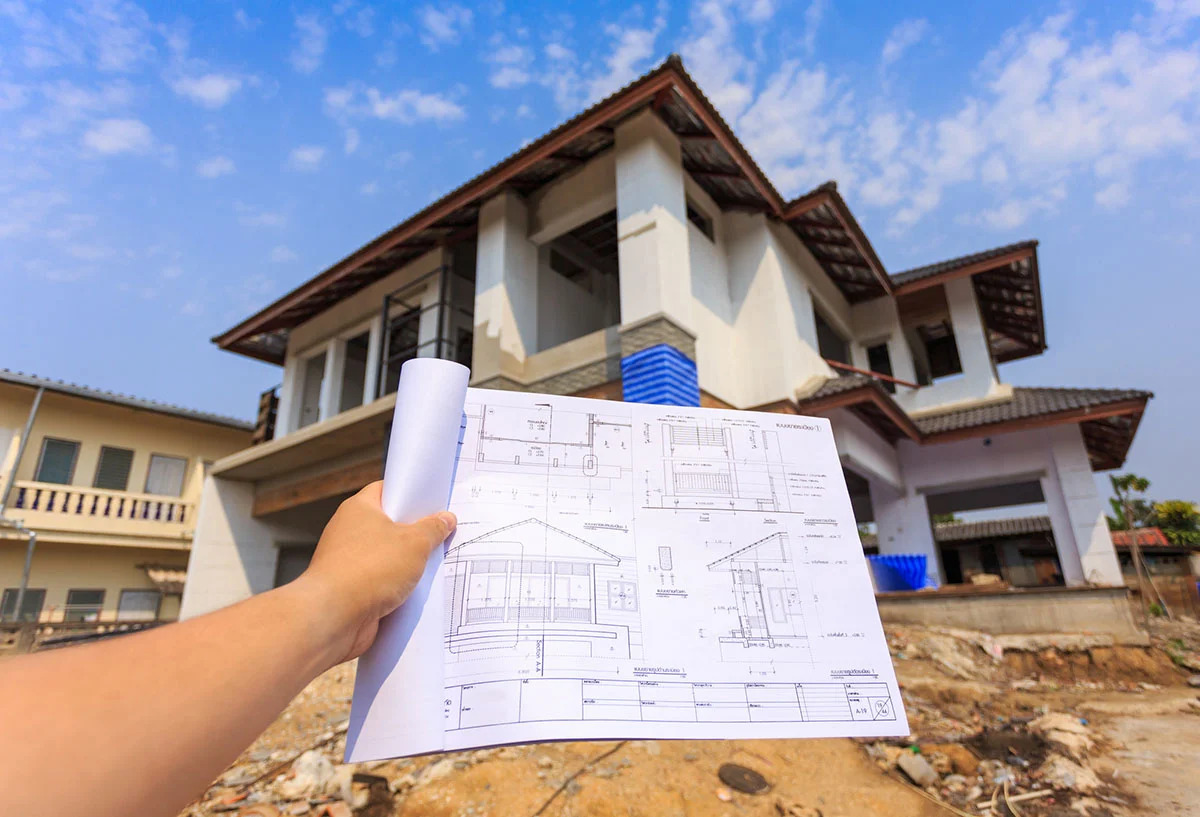Home>diy>Building & Construction>What Is Construction Retainage


Building & Construction
What Is Construction Retainage
Modified: December 7, 2023
Learn about construction retainage in building construction. Understand what it is, how it works, and its importance in project completion and payment.
(Many of the links in this article redirect to a specific reviewed product. Your purchase of these products through affiliate links helps to generate commission for Storables.com, at no extra cost. Learn more)
Introduction
Construction retainage is a term commonly used in the building industry, but it may be unfamiliar to those outside of the construction realm. Retainage refers to a percentage of payment that is withheld by the project owner or general contractor from the contractors and subcontractors until the completion of a construction project. This practice is implemented to ensure the satisfactory completion of the project and to protect the owner from potential issues such as defects or delays.
Construction projects are complex undertakings that involve multiple parties working together towards a common goal. The process includes various stages, from planning and designing to executing and delivering the final product. Throughout this journey, there are risks and uncertainties that could arise, putting the project at stake.
The concept of retainage acts as a safeguard against such risks by allowing the owner to hold a portion of the payment until the project reaches its completion. This serves as an incentive for contractors and subcontractors to fulfill their contractual obligations and meet the desired quality standards within the agreed-upon timeframe.
The purpose of this article is to shed light on construction retainage, exploring its definition, the purpose and importance it serves, the requirements and release process, the impacts it has on contractors and subcontractors, the challenges and legal considerations surrounding it, and potential alternatives to this practice. By gaining a better understanding of construction retainage, stakeholders in the construction industry can navigate the payment process more effectively and mitigate potential disputes.
Key Takeaways:
- Construction retainage is a financial safeguard that incentivizes quality work, timely completion, and risk mitigation. It impacts cash flow, performance, and legal considerations for contractors and owners.
- Owners and contractors can explore alternative payment methods, such as payment bonds and escrow accounts, to achieve project objectives while minimizing financial strain and disputes associated with construction retainage.
Read more: What Is Retainage On A Construction Project
Definition of Construction Retainage
Construction retainage, also known as retention or holdback, is a financial arrangement in the construction industry where a certain percentage of payment is withheld from contractors and subcontractors by the project owner or general contractor until the project is completed and all contractual obligations are fulfilled. This percentage is typically a predetermined amount agreed upon in the contract and is usually a fraction of the total project cost.
The purpose of retainage is to provide the owner with leverage and protection against potential issues that may arise during the course of the project. By retaining a portion of the payment until the final completion, the owner has a financial incentive to ensure that all works are properly executed, and any defects or deficiencies are rectified. Moreover, it gives the owner some recourse in case the contractor or subcontractor fails to complete the project or address any outstanding issues.
Retainage acts as a safety net for both the owner and the contractors involved in the project. It ensures that the contracted work is completed to the specified standards and that the owner receives a satisfactory outcome. Additionally, it guards against any financial risks and uncertainties that may result from potential contractor default, delays, or defects.
Typically, retainage is calculated as a percentage of the total contract value, ranging from 5% to 10% depending on the jurisdiction and the nature of the project. However, it is worth noting that retainage percentages can vary depending on specific contractual agreements or industry standards. It is vital for both parties to clearly define the retainage terms in the contract to avoid any misunderstandings or disputes later in the project.
While retainage is commonly used in the construction industry, it is important to differentiate between retainage and other forms of withholdings, such as liquidated damages and performance bonds. Retainage specifically refers to the withholding of a portion of payment, whereas liquidated damages are financial penalties imposed when a party fails to meet certain contractual obligations. Performance bonds, on the other hand, are a form of insurance that guarantees the completion of the project or covers any financial loss incurred by the owner if the contractor fails to fulfill their obligations.
Purpose and Importance of Construction Retainage
The purpose of construction retainage is to protect the project owner and ensure the successful completion of a construction project. By withholding a portion of payment until the project is finished, retainage serves several important functions:
- Quality Assurance: Retainage incentivizes contractors and subcontractors to perform their work to the best of their abilities and meet the specified quality standards. Knowing that a percentage of their payment is being withheld until the completion of the project, contractors are motivated to deliver workmanship that meets or exceeds expectations.
- Defect and Deficiency Rectification: Retainage provides leverage to the project owner by ensuring that contractors and subcontractors address any defects or deficiencies in the completed work. If there are any issues discovered during the inspection or after the project is completed, the owner can use the withheld payment as leverage to ensure that the necessary corrections are made.
- Time Management and Completion: Retainage acts as a financial incentive for contractors to complete the project within the agreed-upon timeframe. It helps keep the project on schedule, minimizing delays and ensuring timely completion. Contractors are aware that their final payment is contingent upon meeting project milestones, deadlines, and completion dates.
- Risk Mitigation: Construction projects involve inherent risks, such as unforeseen costs, delays, or contractor default. By retaining a portion of payment, the owner has protection against such risks. If the contractor fails to fulfill their contractual obligations or faces financial difficulties, the retainage can be used to cover the costs of completing the project or addressing any resulting issues.
Retainage plays a vital role in maintaining a healthy cash flow for contractors and subcontractors, as it ensures that they receive a significant portion of the payment upon completion of the project. While retainage can place temporary financial strain on contractors, it also provides them with reassurance that they will receive their full payment once all contractual obligations are met.
For owners, retainage offers a level of security and control over the project. It allows them to hold funds until the work is satisfactorily completed, giving them the ability to ensure compliance with plans, specifications, and building codes. The withheld retainage can serve as a backstop in case the project encounters unexpected issues or requires additional work to meet the desired quality standards.
In summary, the purpose and importance of construction retainage lies in its ability to promote quality workmanship, rectify defects, manage project timelines, mitigate risks, and offer financial security to both owners and contractors. By implementing retainage, parties involved in construction projects can reduce the chances of disputes, create accountability, and ensure successful project completion.
Retainage Percentage and Requirements
The retainage percentage and requirements in construction projects can vary depending on various factors, such as the project type, location, industry practices, and contractual agreements. However, there are some common practices and guidelines to consider when determining retainage percentages:
- Industry Standards: Different industries may have established norms or standards for retainage percentages. For example, in the commercial construction industry, it is common to retain 5% to 10% of the contract value. However, this can vary between jurisdictions and project types.
- Project Complexity: The complexity and nature of the project can influence the retainage percentage. Projects that involve high-risk elements, such as intricate designs, unique materials, or complex systems, may have higher retainage percentages to account for the increased potential for issues or delays.
- Contractual Agreements: The retainage percentage should be clearly defined in the contract between the owner and the contractor. This ensures that all parties are aware of the agreed-upon amount and can plan their finances accordingly. It is crucial to review and negotiate the retainage terms before signing the contract to avoid any surprises or disputes later in the project.
- Progress Payments: In some cases, the retainage percentage may change as the project progresses. Initially, a higher retainage percentage may be imposed to safeguard against early-stage risks. As the project reaches certain milestones or stages of completion, the retainage percentage may be reduced to reflect the reduced level of risk.
- Local Laws and Regulations: It is important to consider any local laws or regulations that dictate the maximum retainage percentage allowed. Some jurisdictions may have specific restrictions on retainage percentages to protect contractors and subcontractors from unfair payment practices.
In addition to the percentage, there are certain requirements and conditions related to retainage that should be taken into account:
- Release Conditions: The contract should clearly outline the conditions under which the retainage can be released. Typically, this includes the satisfactory completion of the project, successful inspection, submission of all required documentation, and resolution of any outstanding issues or claims.
- Release Schedule: The contract may also specify the release schedule for the retainage. This could involve partial releases based on project milestones, such as completion of specific phases or percentage of work done, instead of releasing the entire retainage amount at once.
- Retention Period: The contract should define the duration for which the retainage will be held. Typically, this period extends for a certain period after the completion of the project to allow for any latent defects or issues to be detected and resolved.
- Interest on Retainage: Depending on the jurisdiction, there may be requirements for the payment of interest on the retained amount. This interest serves as compensation to the contractor or subcontractor for the delayed payment and helps ensure fairness in the retainage process.
It is crucial for all parties involved in a construction project to fully understand and comply with the retainage percentage and requirements. Clear communication, transparency, and adherence to contractual terms can help minimize disputes and ensure a smoother payment process.
Retainage Release Process
The retainage release process involves the steps and procedures that need to be followed to release the withheld payment to contractors and subcontractors upon completion of the construction project. While the specific details can vary depending on the contract and project requirements, the general process typically includes the following steps:
- Project Completion: The first requirement for the release of retainage is the completion of the construction project. This includes finishing all construction work, addressing any outstanding defects or deficiencies, and obtaining the necessary approvals and certifications.
- Inspection: After the project is deemed complete, an inspection is conducted to ensure that all work has been executed according to the specifications, plans, and building codes. The inspection identifies any remaining issues that need to be rectified before the release of the retainage.
- Submission of Documentation: Contractors and subcontractors are typically required to submit relevant documents and paperwork to support the release of retainage. This may include as-built drawings, operation manuals, warranties, lien waivers, and any other documentation specified in the contract.
- Final Payment Application: Contractors and subcontractors usually submit a final payment application to the project owner or general contractor. This application includes a breakdown of the work completed, the amount of retainage being requested for release, and any supporting documentation or evidence of completion.
- Review and Approval: The owner or general contractor reviews the final payment application and verifies that all contractual obligations have been met. They may conduct a final inspection to ensure that the work is satisfactory and in compliance with the agreed-upon standards. If everything is in order, the release of retainage is approved.
- Retention Period: Depending on the contract, there may be a defined retention period after the completion of the project. This period allows the owner to identify and rectify any latent defects that may emerge. Once this period elapses without any issues, the final release of the retainage is initiated.
- Payment: After the retainage release is approved, the withheld amount is paid to the contractors and subcontractors. This may be done through a final payment transaction, which includes the retainage amount along with any remaining unpaid balances for completed work.
It is important for all parties involved to ensure that they comply with the retainage release process outlined in the contract. Adhering to the specified requirements and timelines helps maintain transparency and accountability. Contractors and subcontractors should keep track of their progress, document their work, and promptly submit the necessary paperwork to facilitate the release of retainage.
By following a structured and systematic retainage release process, construction projects can conclude smoothly, contracts can be fulfilled, and contractors and subcontractors can receive their full payment for the work done.
Construction retainage is a percentage of the contract price withheld by the owner to ensure the contractor completes the project satisfactorily. It’s typically released after project completion and final inspection.
Read more: What Is Retainage In A Construction Loan
Impacts of Construction Retainage on Contractors and Subcontractors
Construction retainage can have significant impacts on contractors and subcontractors throughout the duration of a construction project. While retainage serves the purpose of protecting the owner and ensuring project completion, it can also present challenges and implications for those involved in the construction process:
- Cash Flow Management: Retainage can strain the cash flow of contractors and subcontractors. With a portion of payment being withheld until project completion, contractors may face challenges in covering their expenses, paying subcontractors, and managing ongoing operations. This can be especially burdensome for smaller contractors or those with limited financial resources.
- Increased Financial Risk: In addition to cash flow constraints, retainage also poses an increased financial risk for contractors. If there are delays in project completion or disputes arise, the release of retainage may be further delayed, affecting their ability to meet financial obligations and potentially leading to financial strain or even insolvency.
- Performance and Incentives: On the flip side, retainage can serve as an incentive for contractors and subcontractors to perform their work diligently and deliver high-quality results. The withholding of payment until project completion encourages proper project management and attention to detail, leading to improved performance and customer satisfaction.
- Disputes and Disagreements: Retainage can become a source of contention and disputes between the owner and contractors. Disagreements may arise regarding the appropriate amount of retainage, the release conditions, or the resolution of issues identified during inspections. Timely communication and regular documentation can help mitigate potential disputes.
- Financial Accountability: Retainage provides a financial safeguard for owners, ensuring that contractors and subcontractors address any defects, deficiencies, or outstanding issues before the final payment is made. It holds the contractors accountable for the quality and completion of their work, reducing the risk for owners and protecting their investment.
- Ability to Secure Financing: The presence of retainage in a construction project can impact a contractor’s ability to secure financing from lenders or bonding companies. The withheld payment may be considered as part of the contractor’s assets, but it may not be readily available or eligible for collateralization, potentially affecting their access to credit.
It is essential for contractors and subcontractors to carefully evaluate the retainage terms and conditions before entering into a construction contract. They should assess the potential impacts on their cash flow, financial stability, and ability to meet ongoing obligations. Proper financial planning, including obtaining appropriate payment surety, may be necessary to navigate the challenges associated with retainage.
Communication, collaboration, and proactive management of retainage-related issues are key to minimizing the negative impacts and ensuring a positive working relationship between contractors and owners. By focusing on open lines of communication, adhering to the contract terms, and maintaining transparency throughout the project, contractors and subcontractors can overcome the challenges and maximize the benefits of construction retainage.
Challenges and Legal Considerations
The use of construction retainage can introduce several challenges and legal considerations for both owners and contractors involved in a construction project. These challenges and considerations should be carefully assessed and addressed to avoid disputes and maintain a smooth project progression:
- Cash Flow Management: Contractors and subcontractors may face cash flow challenges due to the retention of a portion of their payment. This can affect their ability to meet financial obligations, pay suppliers and subcontractors, and cover operating costs. Proper cash flow management and financial planning are essential to mitigate these challenges.
- Documentation and Retention Obligations: Contractors and subcontractors need to ensure that they have proper documentation and records of their work to support the release of retainage. This includes maintaining clear and detailed records of completed work, materials used, and any changes or variations. Failure to provide adequate documentation can delay the release of retainage or result in disputes over payment.
- Disputes and Disagreements: Disagreements over the amount of retainage, the conditions for its release, or the resolution of issues identified during inspections can lead to disputes between owners and contractors. Timely communication, regular meetings, and proactive problem-solving can help to resolve disputes and ensure a more satisfactory outcome for all parties.
- Statutory Requirements and Legal Limits: It is important to be aware of any legal requirements or restrictions related to retainage in the specific jurisdiction where the project is taking place. Some jurisdictions have limitations on the percentage of retainage that can be withheld, while others may require the payment of interest on retainage amounts. Compliance with these legal requirements is essential to avoid legal ramifications.
- Lien Rights and Protection: Contractors and subcontractors should be aware of their lien rights and protections available to them. In some cases, retainage withheld may be subject to lien rights, allowing contractors and subcontractors to file a lien against the project if retainage is not released within the specified time frame or if there are payment disputes. Understanding and securing lien rights can help protect their financial interests.
- Contractual Language and Terms: The contract between the owner and the contractor should include clear and specific provisions related to retainage, including the percentage, the release conditions, and the timing of the final payment. It is important to review and negotiate these contractual terms to ensure they are fair and realistic for both parties.
Consulting with legal professionals, such as construction attorneys, and seeking professional guidance can be valuable in navigating the legal considerations and complexities associated with construction retainage. Open communication, proactive documentation, and a clear understanding of the contractual obligations can help mitigate the challenges and potential legal risks associated with retainage.
Addressing these challenges and legal considerations from the outset can help ensure a more harmonious relationship between owners and contractors and promote a successful project outcome.
Alternatives to Construction Retainage
While construction retainage is a commonly used practice in the industry, there are alternatives that can be considered to achieve similar objectives without the same financial impact on contractors and subcontractors. These alternatives can help address cash flow concerns and improve working relationships between owners and contractors:
- Payment Bonds: Owners can require contractors to provide payment bonds, which are issued by a surety company. These bonds serve as a guarantee that subcontractors and suppliers will be paid, even if the contractor fails to do so. Payment bonds provide financial security to all parties involved in the project and can alleviate the need for retainage.
- Escrow Accounts: Instead of retaining a portion of payment, owners can establish an escrow account where a specified percentage of funds is held separately. The funds in the escrow account can serve as security, protecting the owner in case of any issues or disputes. This method allows contractors to receive their full payment upfront while still providing financial protection to the owner.
- Performance-Based Payments: Rather than withholding a percentage of payment as retainage, owners can implement a performance-based payment system. Contractors are paid based on the completion of specific project milestones, achieving certain performance targets, or meeting designated quality standards. This aligns payment with project progress and can incentivize contractors to deliver high-quality work within the agreed-upon timeframes.
- Progressive Milestone Payments: Owners can choose to release payments in progressive milestone installments as the project reaches designated stages of completion. This allows contractors to receive payment for completed work and helps alleviate cash flow challenges by providing a more steady influx of funds throughout the project duration.
- Retention Bonds: Retention bonds, similar to payment bonds, are a form of surety bond that protect the owner against defective work or contractor default. Instead of withholding a portion of the payment, a retention bond is obtained by the owner to ensure that any necessary repairs or corrections can be completed without financial burden to the owner.
When exploring alternatives to construction retainage, it is important for owners and contractors to assess the specific needs and circumstances of the project. Contractual agreements should be negotiated and tailored to consider the potential risks and objectives of both parties involved. Consulting with legal professionals or industry experts can provide valuable guidance in selecting the most suitable alternative to retainage.
Overall, considering alternative payment methods can help promote more efficient cash flow management, reduce financial strain on contractors, and foster trusting relationships between owners and contractors. By exploring these alternatives, owners can ensure the successful completion of their projects while minimizing the financial impact on contractors and subcontractors.
Conclusion
Construction retainage is a widely used practice in the construction industry, serving as a tool to protect owners and ensure the successful completion of projects. While retainage provides financial security and incentivizes quality workmanship, it also presents challenges and implications for contractors and subcontractors.
Understanding the purpose and importance of retainage is essential for all parties involved in construction projects. Retainage acts as a safeguard, ensuring that contractors meet their contractual obligations, rectify defects, and complete the project to the specified standards within the agreed-upon timeframe.
The retainage percentage and requirements can vary depending on industry standards, project complexity, contractual agreements, and local regulations. Owners and contractors need to establish clear retainage terms in the contract and adhere to the requirements and release process outlined.
Construction retainage brings both benefits and challenges. It can strain the cash flow of contractors, increase financial risks, and lead to disputes. However, retainage also encourages performance, ensures accountability, and provides financial protection for owners.
Exploring alternatives to construction retainage can help alleviate some of these challenges. Payment bonds, escrow accounts, performance-based payments, progressive milestone payments, and retention bonds are alternative methods that offer different ways to achieve similar objectives without significant adverse impacts on contractors’ cash flow.
In conclusion, construction retainage is a valuable practice that serves to protect owners and incentivize contractors to deliver quality work. It is important for all parties to understand the retainage process, comply with contractual terms, and maintain open communication to mitigate potential challenges and disputes. Evaluating alternative payment methods can contribute to improved cash flow management and foster positive relationships between owners and contractors.
By navigating the complexities of construction retainage and considering the needs and objectives of all stakeholders, construction projects can be successfully completed, ensuring the satisfaction of owners and the growth and stability of contractors and subcontractors.
Frequently Asked Questions about What Is Construction Retainage
Was this page helpful?
At Storables.com, we guarantee accurate and reliable information. Our content, validated by Expert Board Contributors, is crafted following stringent Editorial Policies. We're committed to providing you with well-researched, expert-backed insights for all your informational needs.















0 thoughts on “What Is Construction Retainage”